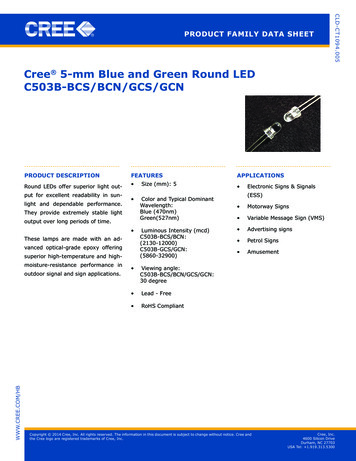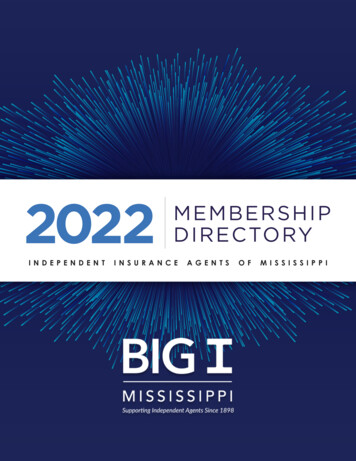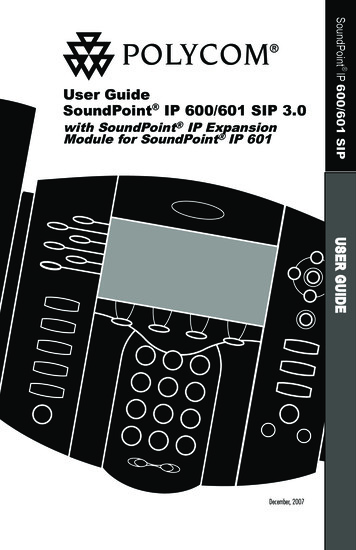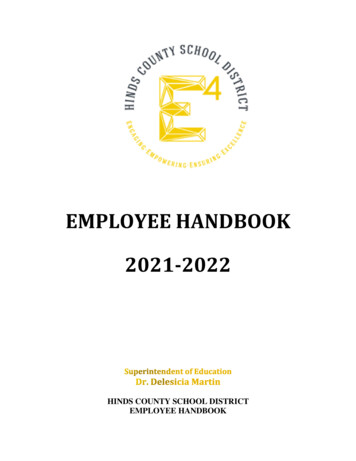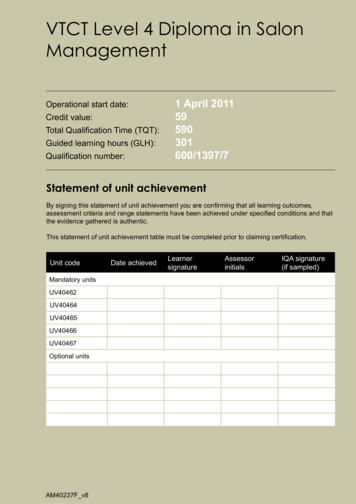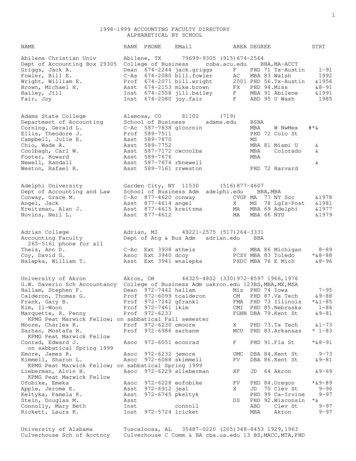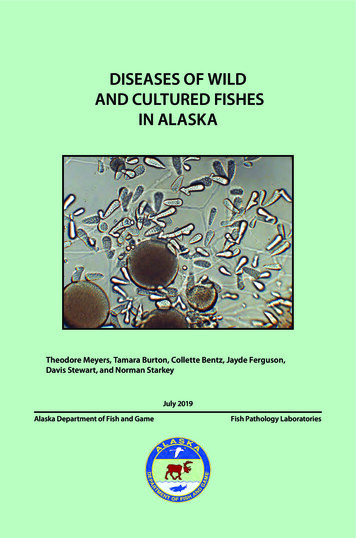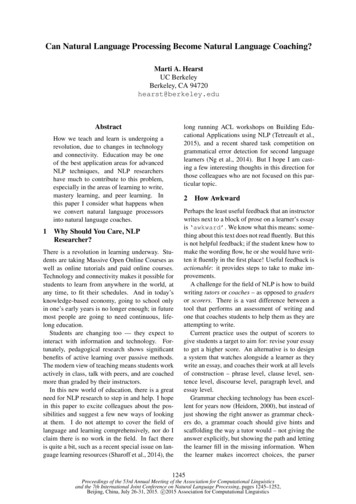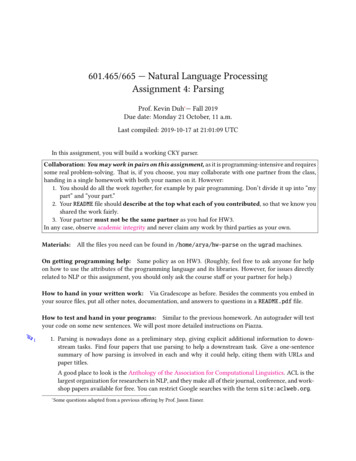
Transcription
601.465/665 — Natural Language ProcessingAssignment 4: ParsingProf. Kevin Duh — Fall 2019Due date: Monday 21 October, 11 a.m.Last compiled: 2019-10-17 at 21:01:09 UTCIn this assignment, you will build a working CKY parser.Collaboration: You may work in pairs on this assignment, as it is programming-intensive and requiressome real problem-solving. That is, if you choose, you may collaborate with one partner from the class,handing in a single homework with both your names on it. However:1. You should do all the work together, for example by pair programming. Don’t divide it up into “mypart” and “your part.”2. Your README file should describe at the top what each of you contributed, so that we know youshared the work fairly.3. Your partner must not be the same partner as you had for HW3.In any case, observe academic integrity and never claim any work by third parties as your own.Materials: All the files you need can be found in /home/arya/hw-parse on the ugrad machines.On getting programming help: Same policy as on HW3. (Roughly, feel free to ask anyone for helpon how to use the attributes of the programming language and its libraries. However, for issues directlyrelated to NLP or this assignment, you should only ask the course staff or your partner for help.)How to hand in your written work: Via Gradescope as before. Besides the comments you embed inyour source files, put all other notes, documentation, and answers to questions in a README.pdf file.How to test and hand in your programs: Similar to the previous homework. An autograder will testyour code on some new sentences. We will post more detailed instructions on Piazza. 11. Parsing is nowadays done as a preliminary step, giving explicit additional information to downstream tasks. Find four papers that use parsing to help a downstream task. Give a one-sentencesummary of how parsing is involved in each and why it could help, citing them with URLs andpaper titles.A good place to look is the Anthology of the Association for Computational Linguistics. ACL is thelargest organization for researchers in NLP, and they make all of their journal, conference, and workshop papers available for free. You can restrict Google searches with the term site:aclweb.org. Some questions adapted from a previous offering by Prof. Jason Eisner.
2. Familiarize yourself with parsing. Try out a context-free parser of English from the literature. Youdon’t have to spend a long time on this question, but experiment by having it parse at least a fewsentences. 2In your README, discuss what you learned. Some examples: Was there anything interesting or surprising about the style of trees produced by the parser? What were some things that the parser got wrong? What were some hard things that it managed to get right? (I.e., “ordinary” sentences of the kind that it probably saw in training data.) Can you design a grammatical sentence that confuses the parser in a way that you intended,even though the parser is familiar with the words in your sentence? (I.e., “adversarial” sentences that are intended to stump the parser, and may be different from the ones in trainingdata.)Hints: The following parsers have online demos, so they are easy to try: Berkeley Parser: ser.html Stanford Parser: http://nlp.stanford.edu:8080/parser/ (for English, Chinese, and Arabic)We’re not asking you to read the manual for the Penn Treebank.1 Just tell us what looks “reasonable”or “unreasonable”. You can find a simple list of nonterminals here:http://cs.jhu.edu/ jason/465/hw-parse/treebank-notation.pdfYou can experiment to figure out the other conventions. For example, if you are not sure whetherthe parser correctly interpreted a certain phrase as a relative clause, then try parsing a very simplesentence that contains a relative clause. This shows you what structures are “supposed” to be usedfor relative clauses (since the parser will probably get the simple sentence right). You can also discusswith other students on Piazza. 33. Not all parsers produce parse trees of the sort we’ve been studying in class (constituency parses).They may produce other kinds of sentence diagrams. One such parsing style is in vogue these days:dependency parsing.2 Try out an online dependency parser. Explain what you notice about it. Alsocompare and contrast it with constituency parses.Please use the spaCy parser: https://explosion.ai/demos/displacy. It may be more educational to you if you disable both “Merge XXX” checkboxes beneath the input field.4. Implement a CKY parser that can be run aspython3 parse.py MODE foo.gr foo.senwhere:1This is the corpus these parsers were trained on, containing about a million English words in 40,000 sentences from the WallStreet Journal.2Nowadays, most dependency parsing algorithms for English leverage neural networks.2
each line of foo.sen is either blank (and should be skipped) or contains an input sentencewhose words are separated by whitespace foo.gr is a grammar file in homework 1’s format, except that– you can assume that the file format is simple and rigid; predictable whitespace and nocomments. (See the sample .gr files for examples.)– the number preceding rule X Y Z is the rule’s estimated probability, Pr(X Y Z X), which is proportional to the number of times it was observed in training data. Theprobabilities for X rules already sum to 13 —whereas in homework 1 you had to dividethem by a constant to ensure this.– you may assume that the grammar is in Chomsky Normal Form—which permits only rulesexpanding into two nonterminals or one terminal. These files are case-sensitive; for example, DT The and DT the have different probabilities. MODE is one of these:– RECOGNIZER, which returns whether the sentence can be parsed according to the grammar– BEST-PARSE, which gives the minimum-weight parse and its weight.– TOTAL-WEIGHT, which gives the log2 of the total probability of a sentence according tothe grammar, in bits. (This is different from the sum of weights!) Execution in this modeis called the inside algorithm.We have provided a sample grammar in flight.gr. It corresponds to the textbook example ofJ&M in Chapter 12, except that Suzanna graciously binarized it for you.4 To sanity-check yourimplementation, make sure you are able to reconstruct the best parse and the total weight for thissentence:book the dinner flight .should have two parses, namely(ROOT (S (Verb book) (NP (Det the) (Nominal (Nominal dinner) (Noun flight)))) (Punc .))(ROOT (S (XB (Verb book) (NP (Det the) (Nominal dinner))) (NP flight)) (Punc .))The probabilities for the top two parses above are 2.16 10 06 , and 6.075 10 07 respectively.Assuming a three-line .sen file, your output should be formatted as follows, depending on SESentence3-Parse Each parse of a sentence should be preceded by its weight, separated by a TAB.34When you read these in, the sums might not be exactly 1. This is a consequence of floating point arithmetic.You can obtain the textbook freely from here.3
Print each weight with 3 decimal places. The parse should be bracketed in the same format as Assignment 1. If there is no parse, print NOPARSE.The weight of a rule or a parse means its negative log2 probability, measured in bits. Thus, theminimum-weight parse is the maximum-probability parse. Your parser should convert probabilities to weights as it reads the grammar file. It can work with weights thereafter.5Hint: All three execution modes can share nearly all of their code! The only difference is a fewparameters. (Can you think of what these are? If so, you’ll save yourself a lot of time.)Not everything you need to write this parser was covered in detail in class! You will have to workout some of the details. Make sure not to do anything that will make your algorithm take more thanO(n2 ) space or O(n3 ) time. Please explain briefly (in your README file) how you solved thefollowing problems, as well as any others that you deem relevant to justify your runtime: 4(a) You only have O(1) time to add the entry to the appropriate column if it is new, so you mustbe able to append to the column quickly. (This should be trivial in Python.)(b) For each entry in the parse chart, you must keep track of that entry’s current best parse (inBEST-PARSE) and the total weight of that best parse. Note that these values may have to beupdated if you find a better parse for that entry.(c) Storing an entire tree at each cell of the chart would be tremendously inefficient, space-wise.What’s a better strategy? 5What to hand in: Submit your parse.py program (as well as answers to the questions above). (Feeling ambitious? Generate sentences with randsent, then parse them with your parser!)The autograder will test your program on new grammars and sentences that you haven’t seen. Youshould therefore make sure it behaves correctly in all circumstances. Remember, your program mustwork not only with the sample grammar, but with any grammar file that follows the correct format,no matter how many rules or symbols it contains. So your program cannot hard-code anythingabout the grammar, except for the start symbol, which is always ROOT. 65. Explain why the complexity of CKY is O(n3 G ). Your answer should elaborate on why each termis present and necessary, not just give the definition of each variable. 7Propose (or identify from the literature) an improvement. Explain it in depth. (More depth thanWikipedia’s summaries—we want to see you comprehend and summarize complex ideas related towhat you’ve learned, not paraphrase Wikipedia.)6. Extra credit: CKY parsers rely on a binarized grammar—one in Chomsky Normal Form. In lecture,we touched on how to binarize a grammar. Now, it’s time to try your hand at it. Write a scriptbinarize.py that accepts a grammar in the format from Assignment 1, then outputs a binarizedform of the grammar.5Alternatively, if you prefer, you can do the conversion at output time instead of at input time. That is, following AppendixG of the previous assignment, your parser can work with probabilities as long as you represent them internally by their logsto prevent underflow. You would then convert log-probabilities to weights only as you print out your results. This is really thesame as the previous strategy, up to a factor of log2 . Hint: If you don’t do it at the end, you may again want to use a library’simplementation of log-sum-exp in TOTAL-WEIGHT.4
Let the binarizer be run as python3 binarize.py grammar.gr --outfile grammar.grb; theoutfile argument is optional. If it is not provided, print the binarized grammar to standard output.Hint: Binarization is meant to give you another form of the same grammar. It should be no more orless expressive than the original. It’s easy to accidentally “loosen” the grammar as you binarize it.Hint: Many of the rules you introduce will have a conditional probability of 1.Hint: There are several possible binarizations of a single grammar. Finding a minimal binarization(the fewest rules) is NP-hard. We’re not asking for the minimal one; any correct binarization will do.Turn in both your binarize.py script and the output of running on /home/arya/hw-parse/wallstreet.gr, saved as wsj grammar.grb.,87. Extra credit: Now that you’ve written a binarized grammar wsj grammar.grb, run it on some testsentences found at /home/arya/hw-parse/wallstreet.sen.To help check your binarized grammar (assuming your parser is correct), for the first two sentencesin wallstreet.sen, their lowest-weighted parses have weights of 34.224 and 104.909 respectively.Turn in BEST-PARSE output of your parser on the first five sentences, along with the probability ofthe best parse. How long did your parser take to process the entire file?,98. Extra Credit: English has been the large focus of natural language processing for decades. As such, itis high-quality tools have been developed for several NLP tasks that use English data. But Ethnologuerecognizes about 7,000 languages in the world. Nearly all of them lack these tools.List some reasons why high-quality NLP tools do not exist in other languages.,10One strategy for combating the lack of tools and annotations in other languages is to project annotations generated by English tools onto other languages across word alignments; e.g. Yarowsky etal. (2001). These alignments can be found by using bilingual dictionaries (some of the first tools created by linguistic field workers), or learned from parallel text as cross-lingual word embeddings orstatistical word alignments. Transferring syntactic information is particularly popular, as in Rasooliand Collins (2017).Help a low-resource language out, projecting your information into the language to improve tagging.Write a script crosslingual.py that leverages your CKY parser, perhaps via an import command.Call your script like this:python3 crosslingual.py mygrammar.gr eng-deu.dict eng.sen deu.senFeeling ambitious? Find a bilingual dictionary (or create it from sentence-aligned corpora with afreely available tool like fast align). Find some text in the language you care about.Feeling stuck? We can give you a toy dictionary and some toy parallel text.If your script reads this English sentence:6The sun shone , having no alternative , on the nothing new .and this (questionable) German translation:6From Samuel Beckett’s Murphy5
Die Sonne schien , ohne eine Alternative zu haben , auf die nichts Neues .then you should parse the English sentence according to your grammar, then use the dictionaryto project preterminals7 across any alignments you find, in this two-line format (separating eachword or preterminal with a tab, marking missing info with a esADJ.PUNCTTell us which language and resources you chose. Submit crosslingual.py via Gradescope. Showus some examples of projected annotations in your writeup.,117These are a particular subset of the nonterminals: in a CNF grammar, these are the left-hand sides of the unary rules.6
Materials: All the les you need can be found in /home/arya/hw-parse on the ugrad machines. On getting programming help: Same policy as on HW3. (Roughly, feel free to ask anyone for help on how t
